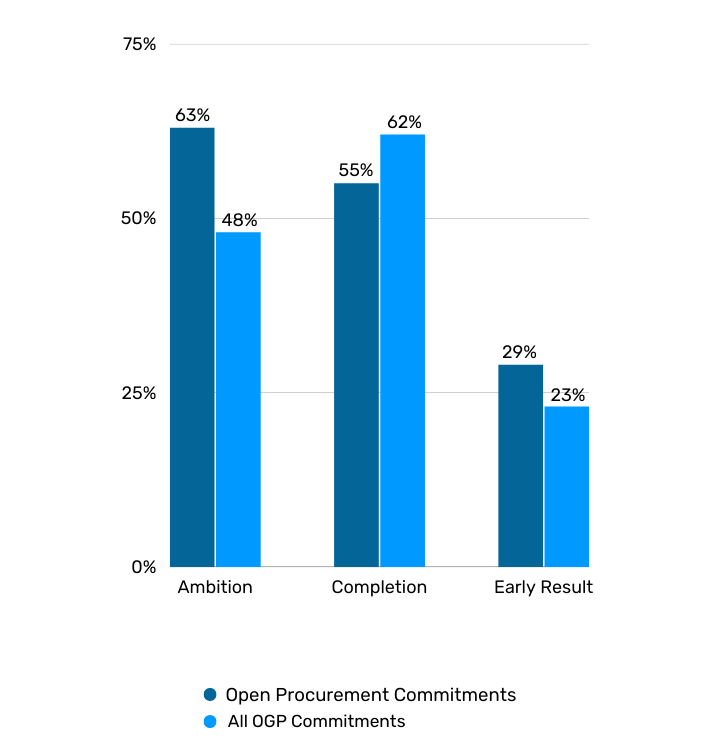Three Factors to Effectively Implement Ambitious Open Procurement Reforms
Tres factores para la implementación efectiva de reformas de contrataciones abiertas
Every year, governments across the world spend over USD $13 trillion (around 12% of global gross domestic product) through public procurement. Yet, various studies show that 10 to 25% of the value of a government contract can be lost to corruption. Applying open government principles to public procurement—through open contracting and public monitoring and reporting mechanisms—can help save money, fight corruption, and expand competition.
In the Open Government Partnership (OGP), the number of commitments advancing open contracting continues to grow. By 2021, three-quarters of OGP members had implemented open contractingA transparent procurement process, known as open contracting, increases competition, improves public service delivery, and ensures governments better value for their money. Technical specifications: C... More and public procurementTransparency in the procurement process can help combat corruption and waste that plagues a significant portion of public procurement budgets globally. Technical specifications: Commitments that aim t... More reforms. Public procurement commitments are more likely to be ambitious (58%), and show strong early resultsEarly results refer to concrete changes in government practice related to transparency, citizen participation, and/or public accountability as a result of a commitment’s implementation. OGP’s Inde... More after implementation (26%), compared to the average of all OGP country commitments.

Here are three factors that could help create more ambitious open procurement reforms and to better implement them.
- Make more high-level political commitments across OGP. In the case of open procurement, high-level political declarations of intent opened the door to numerous and more ambitious open procurement commitments in OGP action plans. For example, the political pledges that came out of the London Anti-Corruption Summit and OGP Paris Declaration in 2016 were coupled with a threefold increase in related commitments in action plans that year.
- Formalize civil society involvement in implementation. The OGP approach encourages active collaboration between governments and civil society organizations (CSOs) to deliver ambitious open government reforms. Examples in public procurement demonstrate how formalizing this collaboration can also have considerable impact on ensuring strong early results.
Implementing recommendations of a procurement monitoring group made up of civil society and public officials greatly enhanced Ukraine’s Prozorro platform in 2016. In its first two years, Prozorro led to nearly USD $2 billion in procurement savings and massively increased the amount of procurement information as open dataBy opening up data and making it sharable and reusable, governments can enable informed debate, better decision making, and the development of innovative new services. Technical specifications: Polici....
In the UK, contractual agreements with government institutions provided CSOs with resources to drive data interoperability and push stakeholders towards working with the Open Contracting Data Standard. The support enabled journalists to use open contracting data to uncover serious shortcomings in the care of vulnerable teenagers by local councils. The Netherlands is taking a similar approach, working with CSOs, private companies, and academia to implement their action plan commitment to open the procurement process.
These formal collaborations can also expand beyond OGP action plans. Honduras’ 2016 OGP commitment on open procurement significantly increased access to procurement information via Honducompras. Building on these reforms, an executive decree has mandated locally led multi-stakeholder bodies, which involve those affected by infrastructure projects, to have an active role in monitoring the way that projects are procured and delivered.
- Respond to crises or windows of opportunity. The COVID-19 pandemic was an unprecedented challenge for civil society and governments around the world. Open government came under intense pressure during the response to the crisis, but there was an opportunity to leverage open procurement reforms. In Lithuania, the scale of emergency procurement spurred action to ensure that such procurement was open and transparent. In Ecuador, the CSO-government collaboration that started under the first OGP action plan helped stakeholders quickly monitor and respond to the delivery of emergency procurement contracts during the COVID-19 pandemic in real time.
Such crises do not wait for OGP action plan cycles to start. Where there is overlap, however, the OGP process can offer additional oversight and independent assessment of such reforms. Action plans developed during the pandemic incorporated ambitious commitments related to COVID-19; for example, Indonesia promised to increase the transparency of budget information related to COVID-19, Kenya committed to including emergency COVID-19 procurement when implementing the Open Contracting Data Standard, and Colombia pledged to bring in citizens to monitor COVID-19-related projects.
There are huge potential benefits in incorporating open government into public procurement reform. Many commitments in OGP processes have shown that incorporating these three factors into the policy-making process can be highly influential.
What other factors are important in promoting ambitionAccording to OGP’s Articles of Governance, OGP commitments should “stretch government practice beyond its current baseline with respect to key areas of open government.” Ambition captures the po... or ensuring progress on implementing open procurement reform? Leave your comments below and let us know what other elements you think help drive implementation of ambitious open procurement reform.
Cada año, los gobiernos de todo el mundo gastan más de 13 billones de dólares (cerca del 12% del producto interno bruto global) en adquisiciones públicas. Sin embargo, varios estudios demuestran que entre el 10 y el 25% del valor de los contratos de gobierno se pierden a causa de la corrupción. Aplicar los principios del gobierno abierto a las adquisiciones públicas a través de la contratación abierta y el monitoreo público y mecanismos de reporte puede ayudar a generar ahorros, luchar contra la corrupción y ampliar la competencia.
En la Alianza para el Gobierno Abierto (OGP, por sus siglas en inglés), ha crecido la cantidad de compromisos enfocados en impulsar las contrataciones abiertas. Para 2021, tres cuartas partes de los miembros de OGP habían implementado reformas de contratación abierta y adquisiciones públicas. Los compromisos sobre adquisiciones públicas tienen mayor probabilidad de ser ambiciosos (58%) y de tener resultados tempranos sólidos tras su implementación, en comparación con el promedio de todos los compromisos de OGP.
A continuación presentamos algunos factores que podrían ayudar a promover reformas de adquisiciones abiertas más ambiciosas y favorecer su implementación.
- Establecer más compromisos de alto nivel político. En el caso de las adquisiciones abiertas, las declaraciones políticas de alto nivel han abierto las puertas a la incorporación de muchos compromisos de contrataciones abiertas en los planes de acción de OGP. Por ejemplo, las promesas políticas generadas tras la Cumbre Anticorrupción de Londres y la Declaración de París de OGP en 2016 resultaron en un incremento de tres veces más compromisos sobre este tema en los planes de acción de ese año.
- Formalizar la participación de la sociedad civil en la implementación. La metodología de OGP promueve la colaboración activa entre los gobiernos y las organizaciones de la sociedad civil para el desarrollo de reformas de gobierno ambiciosas. Algunos ejemplos del área de las adquisiciones públicas demuestran que formalizar esta colaboración puede generar resultados más sólidos.
La plataforma Prozorro de Ucrania se fortaleció gracias a la implementación de recomendaciones planteadas en 2016 por un grupo de monitoreo establecido por organizaciones de la sociedad civil y funcionarios. En sus primeros dos años, Prozorro generó cerca de dos mil millones de dólares en ahorros e incrementó enormemente la cantidad de información de adquisiciones, publicada como datos abiertos.
En el Reino Unido, los contratos con las instituciones de gobierno otorgaron a las organizaciones de la sociedad civil recursos para impulsar la interoperabilidad de datos y promover la adopción del Estándar de Datos para las Contrataciones Abiertas. Así, las y los periodistas tuvieron la oportunidad de utilizar los datos de contrataciones abiertas para revelar debilidades importantes en el cuidado de adolescentes vulnerables por parte de los consejos locales. Los Países Bajos bajo una estrategia similar, están trabajando con organizaciones de la sociedad civil, empresas y la academia para implementar un compromiso con el fin de abrir los procesos de adquisiciones, como parte del plan de acción.
Estas colaboraciones formales pueden ampliarse más allá de los planes de acción de OGP. El compromiso de Honduras de OGP de 2016 sobre adquisiciones abiertas incrementó en su momento de forma significativa el acceso a información sobre adquisiciones gracias a la creación de Honducompras. A partir de estas reformas, un decreto ejecutivo exige la creación de organismos locales multiactor, en los que participan las personas afectadas por proyectos de infraestructura, con el fin de monitorear activamente el desarrollo de proyectos.
- Responder a las crisis o ventanas de oportunidad. La pandemia por la COVID-19 fue un reto sin precedentes para la sociedad civil y los gobiernos de todo el mundo. El gobierno abierto estuvo bajo una gran presión durante la respuesta a la crisis, pero se abrió la oportunidad de promover reformas de adquisiciones abiertas. En Lituania, la escala de la emergencia de adquisiciones motivó acciones para asegurar que las adquisiciones fueran abiertas y transparentes. En Ecuador, la colaboración entre organizaciones de la sociedad civil y el Gobierno que inició durante el primer plan de acción de OGP ayudó a las y los actores a monitorear la ejecución de contratos de adquisiciones de emergencias durante la pandemia por la COVID-19 en tiempo real.
Este tipo de crisis no espera a que inicien los ciclos de los planes de acción de OGP. Sin embargo, en los casos en los que sí coinciden, los procesos de OGP pueden ofrecer mayor supervisión y una evaluación independiente de dichas reformas. Los planes de acción desarrollados durante la pandemia incluyeron compromisos ambiciosos relacionados con la COVID-19; por ejemplo, Indonesia se comprometió a incrementar la transparencia de la información presupuestaria con relación a la COVID-19; Kenia se comprometió a incluir información sobre las adquisiciones asociadas a la COVID-19 en la implementación del Estándar de Datos para las Contrataciones Abiertas y Colombia se comprometió a involucrar a la ciudadanía en el monitoreo de los proyectos relacionados con la COVID-19.


Leave a Reply